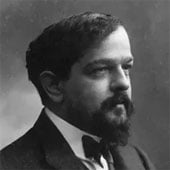
Claude Debussy
There are few composers who set the course for their successors to the same extent as Debussy. As well as being at the vanguard of the transition from romanticism to modernism, he began the practice, along with Ravel, of musical impressionism, the notion that a work should suggest the atmosphere and environment of the subject, rather than attempt to be fully descriptive and programmatic.
Although Debussy was known to have disliked the term, no two pieces fully encapsulate the then-revolutionary impressionist style better than his Prélude l’après-midi d’un faune and La Mer. Both immediately conjur images of their respective subjects brilliantly, yet never fall into the sentimentality and melodrama that Debussy strove to avoid.
Debussy’s piano writing completely altered the way in which the instrument was perceived. His music, like much of Ravel’s, aims for a "hammerless piano" – a sound almost devoid of percussiveness, which instead gives way to lush, smooth soundworlds. Look no further for an example of this than his La Cathédrale engloutie, a work based on the legend of the cathedral of the mythical town of Ys; the cathedral submerges into the sea due to sin, only to gloriously rise again at sunrise.
